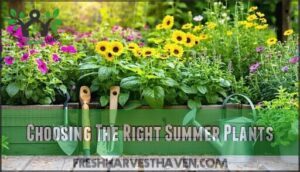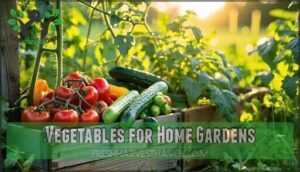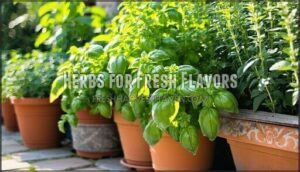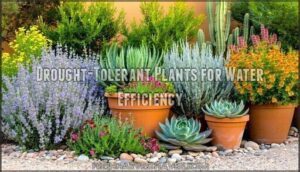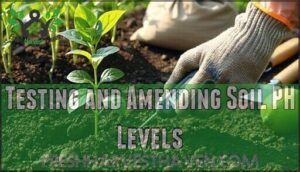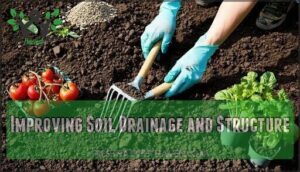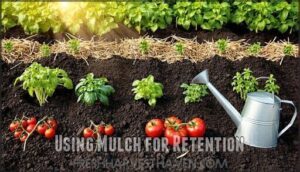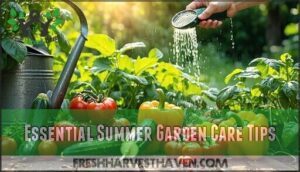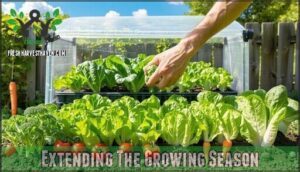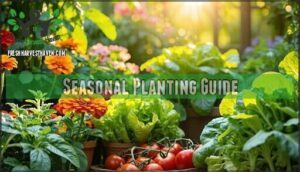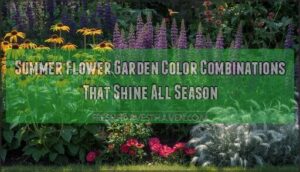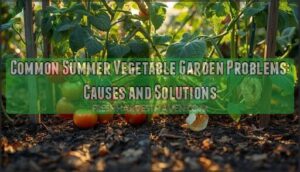This site is supported by our readers. We may earn a commission, at no cost to you, if you purchase through links.

Consider your local climate zone and last frost date when selecting varieties. Heat-loving crops like tomatoes, peppers, and squash are summer stars. For beginners, try reliable options like zinnias, marigolds, and basil—they’re practically foolproof.
Don’t forget about spacing; overcrowded plants compete for nutrients and invite disease. Think about your watering schedule too. Drought-tolerant plants like lavender and succulents save time and water bills.
The secret lies in matching plants to your specific conditions rather than fighting against them, which is a key factor in maintaining a healthy and thriving garden with minimal effort and drought-tolerant plants.
Table Of Contents
- Key Takeaways
- Choosing The Right Summer Plants
- Popular Summer Garden Plants
- Preparing The Soil for Planting
- Essential Summer Garden Care Tips
- Extending The Growing Season
- Seasonal Planting Guide
- Frequently Asked Questions (FAQs)
- What is the best way to arrange plants in a garden?
- How do I decide what to plant in my garden?
- What is the best plant to plant in the summer?
- What vegetable grows best in hot weather?
- What is the best plant to plant in summer?
- What are the 5 summer vegetables?
- When should I start my summer garden?
- What is the easiest vegetable to grow in summer?
- What colors for summer garden?
- How to protect plants from intense summer heat?
- Conclusion
Key Takeaways
- Match your plants to your garden’s specific conditions—check sunlight hours, soil pH, and climate zone before choosing what to grow
- Focus on heat-tolerant varieties like tomatoes, peppers, marigolds, and lavender that’ll thrive in summer’s blazing temperatures
- Give plants proper spacing and good soil preparation with organic matter to prevent overcrowding and disease problems
- Time your plantings right by starting heat-loving crops after the last frost date when soil temperatures reach 60°F consistently
Choosing The Right Summer Plants
Selecting the right summer plants sets the foundation for a thriving garden that’ll reward you with abundant harvests and vibrant blooms all season long.
You’ll need to match your plant choices to your garden’s specific conditions—from sunlight exposure and soil quality to local climate patterns and available growing space, which is crucial for a vibrant garden.
Evaluating Sunlight and Shade Conditions
Sunlight-mapping mastery starts with understanding your garden’s unique light patterns. You’ll need accurate sunlight evaluation to match plants with their ideal growing conditions. Understanding cardinal direction exposure can greatly aid in determining sun exposure.
- Track sunlight duration hourly across different garden areas for complete microclimates analysis
- Map shade patterns created by buildings, trees, and structures throughout the day
- Position full sun plants (6+ hours) in brightest spots; place part shade plants in morning light zones
- Match light intensity requirements—shade loving plants thrive with filtered light while full sun varieties need direct exposure
Assessing Soil Quality and PH Levels
Your garden’s success depends on what’s happening beneath the surface. Soil testing methods like DIY pH kits reveal whether your soil pH falls within the ideal 6.0-7.0 range for summer plants.
Soil test results guide pH adjustment using lime or sulfur. Organic amendments like compost improve soil composition and address nutrient deficiencies.
Check drainage assessment by digging—water shouldn’t pool after heavy rain. To guarantee optimal growth, gardeners should understand healthy soil characteristics, including fertility and drainage.
Considering Plant Size and Spacing Needs
Once you’ve checked your soil pH, consider how mature size affects your summer garden plants‘ success.
Smart spacing prevents overcrowding risks and guarantees proper air circulation around each plant.
Follow these spacing guidelines:
- Research each plant’s full-grown dimensions and root depth requirements
- Allow adequate space between plants to prevent sunlight competition
- Design pathways in your raised bed gardening layout for easy maintenance access
- Consider container gardening for plants with extensive spreading habits
Proper plant spacing transforms cramped gardens into thriving productive spaces.
Selecting Plants for Local Climate and Season
Smart plant selection transforms your summer garden from surviving to thriving. Understanding your USDA Hardiness zone helps you choose plants that’ll handle your local climate like champs.
Check rainfall patterns and heat tolerance before planting—drought resistant plants like lavender laugh at water restrictions, while heat tolerant plants such as peppers embrace scorching afternoons.
| Climate Factor | Recommended Plants | Success Tips |
|---|---|---|
| Full Sun (6+ hours) | Tomatoes, Zinnias, Sunflowers | Choose heat tolerant varieties |
| High Heat Zones | Peppers, Squash, Marigolds | Native species adapt best |
| Low Rainfall Areas | Sedums, Succulents, Thyme | Focus on local adaptation |
| Humid Conditions | Basil, Cucumbers, Beans | Make certain good air circulation |
| Variable Weather | Native wildflowers, Herbs | Local plants handle surprises |
Companion Planting for Growth and Pest Control
Pairing plants strategically transforms your garden into a natural pest control system.
Basil and tomatoes make perfect partners—basil repels thrips while enhancing tomato flavor. Marigold deterrents release compounds that reduce nematodes and harmful insects.
Trap cropping with nasturtiums diverts aphids from valuable crops. Pollinator attraction flowers like borage boost fruit set, while diverse bloom times support beneficial insects throughout summer.
This companion planting approach reduces reliance on organic pesticides while maximizing yields.
Popular Summer Garden Plants
Summer gardens offer endless possibilities when you know which plants thrive in hot weather conditions.
You’ll find success with heat-loving vegetables, colorful flowers, and practical herbs that handle intense sunlight and warm temperatures, allowing for a variety of colorful choices.
Vegetables for Home Gardens
Summer vegetable varieties transform your backyard into a productive harvest zone. Heat-loving crops like tomatoes, peppers, and cucumbers thrive with proper garden layout and container gardening options.
Vertical growing maximizes space while organic methods guarantee healthy plants. Focus on watering tips and fertilizing plants consistently for your summer vegetable garden success.
- Bite into sun-warmed tomatoes that taste like pure summer sunshine
- Harvest crisp cucumbers perfect for invigorating afternoon snacks
- Pick colorful peppers that add vibrant flavor to every meal
- Watch vegetables grow from tiny seeds into abundant producers
- Create lasting memories tending your own food source
Annuals and Perennials for Color
Beyond vegetables, you’ll want annual color and perennial return for lasting beauty.
Summer annuals like marigolds and zinnias provide instant summer blooms, while summer perennials like lavender offer year-after-year value.
Mix bloom times for continuous color—early marigolds with late-season sunflowers.
Choose native varieties when possible for easier care.
Plant pollinator-friendly options like zinnias for attracting pollinators while creating stunning displays.
Herbs for Fresh Flavors
Why not transform your garden into a flavor powerhouse with fresh summer herbs?
Basil and oregano thrive in full sun, delivering culinary herb uses from Italian dishes to Mediterranean herb blends.
Plant cilantro for salsas, while mint’s cooling properties shine in drinks—just contain it since it spreads aggressively.
These herbs offer medicinal herb benefits and work beautifully in herb garden design, whether you’re growing herb indoors or outdoors, plus they’re perfect for drying fresh herbs.
Drought-Tolerant Plants for Water Efficiency
While herbs add flavor to your kitchen, drought-resistant plants tackle summer’s biggest challenge: water conservation. Smart gardeners embrace xeriscaping principles to create stunning landscapes that thrive without constant irrigation. These heat-tolerant plants deliver beauty while slashing water bills by over 50% compared to traditional gardens.
Native varieties and succulent gardens form the backbone of water-wise landscaping:
- Stonecrop (Sedum) stores water in fleshy leaves for weeks between waterings
- Lavender provides fragrance while thriving in blazing heat
- Yarrow produces vibrant blooms during extended dry spells
- Russian Sage offers silver foliage and purple flowers with minimal water
- Coneflower attracts pollinators while surviving drought conditions
Proper irrigation methods focus on deep, infrequent watering during establishment.
Plants for Shady Areas
Don’t let shade tolerances discourage your gardening dreams.
Shade-loving plants like impatiens and coleus provide vibrant color without full sun requirements. Hostas offer striking foliage interest for woodland gardens, while ferns create natural texture.
Best groundcovers include ajuga and pachysandra for difficult spots. Container options let you move shade-loving annuals as needed.
Perennial shade options like astilbe return yearly, making shady corners productive parts of your summer garden plants collection.
Preparing The Soil for Planting
You’ll need to prepare your soil before planting to give your summer garden the best chance of success.
Proper soil preparation involves testing pH levels, adding organic matter, improving drainage, and applying mulch to create ideal growing conditions.
The process is crucial for summer garden success, and by following these steps, you can ensure your garden thrives.
Testing and Amending Soil PH Levels
Soil pH dictates whether your plants thrive or struggle. Most vegetables prefer pH 6.0-7.0 for maximum nutrient absorption.
Your garden’s pH holds the key to plant success—get it right and watch everything flourish.
Test your soil using DIY strips or professional lab analysis every few years. Acidic soil needs lime to raise pH, while alkaline conditions require sulfur amendments.
Apply organic amendments like compost during pH adjustments to buffer changes. Digital pH meters provide precise readings when calibrated properly.
You can buy a reliable pH meter for accurate soil testing. Gradual pH shifts over months prevent plant shock and guarantee lasting soil improvements, ensuring a healthy environment for your plants to thrive.
Adding Organic Matter for Fertility
Organic matter transforms your garden into a thriving ecosystem.
Compost benefits include improved soil structure and enhanced nutrient cycling, while aged manure types provide essential nutrients for robust plant growth.
- Compost creates nutrient-rich soil that retains moisture and feeds beneficial microorganisms
- Well-aged manure delivers slow-release nutrients without burning delicate plant roots
- Green manures like clover fix nitrogen naturally while improving soil health between seasons
Improving Soil Drainage and Structure
After enriching your soil with organic matter, proper drainage becomes your next priority for plant success.
Compacted soil suffocates roots and creates waterlogged conditions that kill plants. Soil aeration breaks up dense layers, while tilling depth of 12 inches allows roots to penetrate freely. Heavy clay benefits from sand or gravel amendments for improved water flow.
- Raised beds solve drainage problems instantly
- Regular compost amendments improve soil structure continuously
Well-drained soil paired with organic matter like well-rotted manure creates the foundation for thriving summer gardens.
Using Mulch for Retention
Effectiveness stands at the heart of successful mulch application for summer gardens. You’ll discover that organic options like bark chips and straw provide excellent moisture retention while gradually enriching your soil as they decompose.
| Mulch Types | Application Depth |
|---|---|
| Bark chips | 2-4 inches |
| Straw/leaves | 3-4 inches |
| Grass clippings | 1-2 inches |
Apply mulch after soil warms but before summer heat peaks. This timing maximizes weed suppression and soil temperature control. Keep mulch 2-3 inches from plant stems to prevent moisture-related diseases.
Your watering techniques become more efficient as mulch reduces evaporation by up to 70%. Stone mulches work well for drought-tolerant plants, requiring minimal summer garden maintenance.
To guarantee proper drainage, consider loosening soil for aeration before applying mulch. Monitor moisture levels beneath organic mulches to prevent waterlogged conditions that harm roots.
Essential Summer Garden Care Tips
Once you’ve chosen and planted your summer garden, proper care becomes essential for healthy growth and abundant harvests.
These essential maintenance practices will help your plants thrive through hot weather and produce the best results all season long, ensuring a successful and abundant harvests.
Watering Strategies for Healthy Growth
Now that you’ve prepared your soil perfectly, proper watering becomes your garden’s lifeline. Deep watering techniques—delivering 1-2 inches weekly—encourage roots to grow downward, creating drought-resistant plants that won’t wilt when temperatures soar.
Morning watering works like clockwork, giving plants time to absorb moisture before afternoon heat kicks in. Drip irrigation systems target water directly to root zones, cutting waste by 50% compared to sprinklers.
Watch for overwatering signs like yellowing leaves or soggy soil—even water-loving tomatoes can drown. Smart watering strategies mean checking soil moisture with your finger before turning on the hose.
Efficient irrigation isn’t just about conservation; it’s about plant health. Morning hydration reduces fungal diseases that thrive in evening dampness.
Mulch benefits extend beyond weed control—organic mulch retains soil moisture, reducing your watering frequency while enriching soil as it decomposes.
Mulching and Weed Control Techniques
Smart mulching tackles two problems at once—keeping weeds down and moisture in.
Organic mulches like wood chips feed your soil while working. Consider using various types available to suit your garden’s needs.
Manual weeding beats herbicide use every time:
- Pull weeds after rain when roots slip out like butter
- Layer organic mulch 3 inches thick as natural weed barriers
- Try soil solarization for stubborn problem areas using clear plastic
Dealing With Pests and Diseases
Garden battles against pests and diseases require strategic thinking and early intervention.
Strike fast when you spot trouble—early action saves your entire harvest.
Monitor your plants daily for telltale signs like aphid clusters or spider mite webbing, then deploy organic pesticides such as neem oil for immediate relief.
Beneficial insects like ladybugs provide ongoing natural pest control, while disease-resistant varieties offer built-in protection against common fungal issues.
| Common Problem | Early Signs | Treatment |
|---|---|---|
| Aphids | Sticky honeydew, curled leaves | Ladybugs, insecticidal soap |
| Powdery Mildew | White fungal coating | Neem oil, proper air circulation |
| Spider Mites | Fine webbing, stippled leaves | Water spray, beneficial predators |
Fertilization and Pruning Best Practices
After managing pests and diseases, proper fertilization and pruning keep your plants thriving through summer’s heat.
You’ll want to match fertilizer types to your plants’ specific needs—organic fertilizers like compost tea work wonders for vegetables, while balanced synthetic options provide quick bloom boost for flowers.
Pruning techniques vary by growth habits, but clean cuts always prevent disease prevention issues.
Essential fertilization and pruning practices:
- Feed smart: Apply fertilizers during early morning when plants absorb nutrients best
- Prune with purpose: Remove dead or diseased growth to redirect energy toward healthy development
- Watch for signals: Yellowing leaves often indicate nutrient deficiencies requiring targeted treatment
Extending The Growing Season
You can extend your garden’s productivity well beyond summer’s end with the right techniques and timing.
Smart season extension methods let you harvest fresh vegetables through fall and even into winter, maximizing your garden investment.
Using Greenhouses and Cold Frames
Beyond proper watering and pest management, greenhouses and cold frames become your secret weapons for extending growing seasons and maximizing harvests.
These season extenders offer unmatched temperature control and frost protection, letting you start seeds earlier and grow heat-loving plants longer.
Here’s how to make them work:
- Maximize space efficiency with vertical shelving and compact greenhouse designs
- Prevent overheating by installing automatic vents or exhaust fans
- Shield vulnerable seedlings with cold frames during temperature swings
- Conduct cost-benefit analysis before investing in heated structures for winter growing
Starting Seeds Indoors
Beyond greenhouse protection, seed starting indoors gives you complete control over your garden’s timeline.
You’ll need quality potting mix, proper indoor lighting options, and consistent temperature control around 65-75°F for maximum germination rates.
This indoor propagation method using seed starting medium guarantees stronger seedlings.
Remember seedling hardening – gradually expose plants to outdoor conditions before transplanting to prevent shock.
| Component | Purpose |
|---|---|
| Seed starting medium | Provides drainage and nutrients |
| Indoor lighting | Ensures adequate photosynthesis |
| Temperature control | Maintains consistent germination temperature |
| Hardening process | Prevents transplant shock outdoors |
Using Row Covers and Frost Blankets
When unexpected cold snaps threaten your tender plants, row covers and frost blankets become your garden’s insurance policy.
These protective materials offer frost protection while maintaining light transmission for healthy growth.
Choose your garden covers wisely:
- Lightweight fabrics for temperature regulation without overheating
- Fine mesh options for pest exclusion during growing season
- Heavier frost blankets for severe weather events.
Material selection affects performance—spun fabrics provide better plant protection than plastic sheeting.
Planting Fall Crops for Extended Harvest
After protecting your summer plants with row covers, you’ll want to start fall crops for extended harvest.
Plant hardy fall vegetables like kale, carrots, and Brussels sprouts during late summer planting, about 6-8 weeks before frost.
Practice crop rotation by replacing spent summer vegetables with cool-season varieties.
Enrich soil with compost and apply mulch for soil insulation and frost protection.
To accurately time plantings, consider using historical frost data.
This winter gardening strategy keeps your table stocked.
Seasonal Planting Guide
You’ll achieve better harvests when you time your plantings to match each season’s growing conditions.
This guide breaks down what to plant and when, helping you maintain a productive garden year-round.
Spring Planting for Summer Harvest
Spring planting sets the foundation for your summer harvest. Start cool-weather crops like lettuce, spinach, peas, and radishes early—they’ll mature before summer’s heat arrives.
Check your frost date and begin seed starting indoors 4-6 weeks prior for warm-season favorites like tomatoes and peppers. Early varieties often outperform late plantings, giving you more time to enjoy fresh produce.
Soil warming techniques like mulching help seeds germinate faster once temperatures rise. Practice succession planting by sowing crops every two weeks—you’ll extend your harvest window substantially.
This strategic spring planting approach guarantees your summer garden plants thrive when temperatures soar.
Summer Planting for Fall Harvest
Smart gardeners maximize their harvest by planting summer vegetables for fall rewards.
Here’s your summer planting strategy:
- Crop rotation refreshes soil nutrients while confusing pests between seasons
- Succession planting beans and beets every two weeks extends your fall harvest
- Overwintering techniques help hardy greens like kale survive first frosts
Plant fast-growing summer vegetables like bush beans in July—they’ll mature before frost hits, giving you fresh produce when neighbors’ gardens fade.
To guarantee the best growth, remember to adjust for slower fall growth by adding two weeks to the maturity date.
Fall Planting for Winter Harvest
Fall planting transforms your garden into a winter treasure trove. Several cold-hardy varieties thrive when temperatures drop, giving you fresh produce through the coldest months.
Kale, Brussels sprouts, and leeks handle frost like champions. Carrots and parsnips actually taste sweeter after cold exposure—nature’s candy factory at work. You’ll want to plant these gems 10-12 weeks before your first hard freeze.
| Crop | Plant Timing | Harvest Period |
|---|---|---|
| Kale | Late August | Through winter |
| Carrots | Early September | December-February |
| Brussels Sprouts | Mid-July | November-January |
Soil insulation becomes your secret weapon. Layer mulch around plants to regulate temperature and protect roots from freeze-thaw cycles. This seasonal planning strategy extends harvest well into winter, making those grocery store trips less frequent when snow flies.
Winter Planting for Spring Harvest
Winter planting sets the foundation for your spring garden’s success. Think of it as nature’s prep work—while everything looks dormant, seeds are quietly preparing for their grand entrance.
Winter Sowing works best with coldhardy varieties that need cold stratification. Time your dormant planting around frost dates and wait for soil thawing before direct seeding. Dormancy breaking happens naturally through winter’s freeze-thaw cycles.
Here’s your winter strategy:
- Plant overwintering garlic, shallots, and onions for summer harvest
- Use cold frames for frost protection during harsh weather
- Start hardy greens like spinach and mache in protected areas
- Leave root crops like carrots in ground for sweeter spring flavors
- Apply mulch to insulate soil and protect emerging seedlings
Frequently Asked Questions (FAQs)
What is the best way to arrange plants in a garden?
Arrange plants by height, placing tall ones like tomatoes and sunflowers in back, medium herbs in middle, and short ground covers in front.
Consider mature size, sunlight needs, and companion planting benefits.
How do I decide what to plant in my garden?
Consider your climate, soil conditions, and available sunlight first. Test soil pH and match plants to their needs. Choose varieties suited to your USDA zone and seasonal timing for success.
What is the best plant to plant in the summer?
Tomatoes are your summer superstar – they love full sun, handle heat well, and produce abundant harvests. You’ll get fresh salads and sauces all season long.
What vegetable grows best in hot weather?
Heat’s fierce grip transforms gardens into blazing battlefields where only the strongest survive.
You’ll find success with tomatoes, peppers, melons, beans, and squash—they’re heat warriors that actually thrive in scorching temperatures above 80°F.
What is the best plant to plant in summer?
You’ll want heat-loving plants that thrive in summer’s blazing temperatures. Tomatoes, peppers, and cucumbers are your best bets—they absolutely love full sun and warm soil conditions.
What are the 5 summer vegetables?
Over 90% of home gardeners plant these five summer staples: tomatoes, peppers, cucumbers, zucchini, and beans. You’ll get fresh produce all season long with these heat-loving champions.
When should I start my summer garden?
Start your summer garden 2-4 weeks after your area’s last frost date, when soil temperatures consistently reach 60°F. You’ll plant warm-season crops like tomatoes, peppers, and cucumbers for ideal growth.
What is the easiest vegetable to grow in summer?
Radishes grow like green lightning in summer heat.
You’ll harvest these foolproof vegetables in just 30 days.
They thrive in full sun, tolerate poor soil, and need minimal care—perfect for beginners wanting quick success.
What colors for summer garden?
Choose vibrant colors that thrive in heat: bright red tomatoes, yellow sunflowers, orange marigolds, purple eggplants, and white zinnias.
These heat-loving plants create stunning visual contrast while attracting pollinators to your garden.
How to protect plants from intense summer heat?
While you might think summer’s blazing sun will fry your plants, strategic protection keeps them thriving.
Use shade cloth, mulch heavily, water deeply in mornings, and consider relocating containers to cooler spots during heat waves.
Conclusion
Research shows that 35% of new gardeners abandon their plots by mid-summer due to poor plant selection.
Successfully choosing the right summer garden plants comes down to matching varieties to your specific conditions rather than fighting against them.
You’ll save time, water, and frustration by selecting heat-tolerant vegetables, drought-resistant flowers, and native species suited to your climate zone.
Remember to take into account sunlight requirements, soil conditions, and spacing needs when planning your layout.
With proper plant selection, you’ll enjoy a thriving garden that practically takes care of itself throughout the hottest months.
- https://thetreetrove.com/what-to-plant-in-my-garden/
- https://www.mydomaine.com/summer-plants-5186164
- https://tblawncare.com/protecting-your-garden-from-summer-pests-and-diseases/
- https://stacyling.com/garden-tour-summer-perennials-pest-and-disease-control/
- https://www.butchartgardens.com/summer-garden-insights-2019/

